Click on images to enlarge

habit (Photo: Sheldon Navie)

compound leaves (Photo: Sheldon Navie)

flower clusters (Photo: Sheldon Navie)

close-up of flowers, each with six yellow sepals and six yellow petals (Photo: Sheldon Navie)

close-up of floral bracts and immature fruit (Photo: Sheldon Navie)

young root sucker (Photo: Sheldon Navie)
Scientific Name
Mahonia pinnata (Lag.) Fedde
Synonyms
Berberis fascicularis (DC.) SimsBerberis pinnata Lag.Mahonia fascicularis DC.Mahonia leschenaultii (Wall.) Takeda (misapplied)
Family
Berberidaceae
Common Names
California barberry, cluster holly-grape, holly grape, mahonia, shiny-leaf barberry, shinyleaf mahonia, wavyleaf barberry
Origin
Native to south-western USA (i.e. south-western Oregon and western California) and northern Mexico.
Naturalised Distribution
Naturalised in some parts of south-eastern Australia (i.e. on the central and southern tablelands of New South Wales and in the ACT).
Notes
Wavyleaf barberry (Mahonia pinnata) is regarded as an environmental weed in south-eastern New South Wales and as a "sleeper weed" in other parts of south-eastern Australia. This species is often cultivated as a garden ornamental in temperate regions. It produces small grape-like fruit and is spread into natural areas by birds.
Wavyleaf barberry (Mahonia pinnata) was first recorded as naturalised in New South Wales in 1987, and is an occasional weed of gullies in the Blue Mountains and Southern Tablelands regions of this state.

